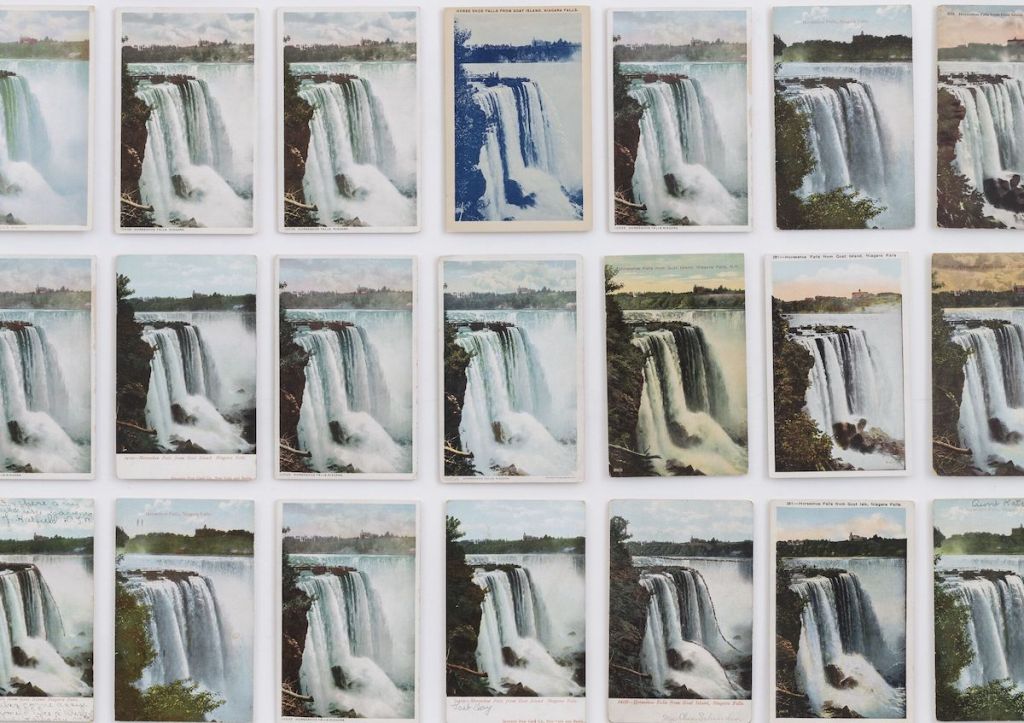From February 24 to April 1, the new exhibition at SBCC’s Atkinson Gallery challenges visitors with a big question. Indeed, “What is America?” is a bigger question than America itself. It’s the prerogative of the immigrant, the Native, the National, and even those who don’t reside here to ask and answer it. Walking into the gallery, the visitor wonders how light bulbs, postcards, and coal dust could capture the humbling complexity of this nation. As one walks out, the answer the show provides seems fitting in hindsight.
The light bulbs are by Felix Gonzalez-Torres. They pair with a video from a previous installation called “Specific Objects Without Specific Form.” The film shows technicians installing lights and loading wrapped candies. There’s something weirdly enrapturing about hearing hundreds of bulbs kissing the floor, along with the shoveling melody of 42 pounds of foil-wrapped Baci chocolates. One wonders if their music stems from their fungibility — the noise of the undifferentiated mass masks the condition of a lone bulb or a single wrapped sweet. And there, at the junction of the collective and the individual, lies the colossal power of the artist’s work. Gonzalez-Torres’s oeuvre has often been interpreted through the lens of his experience with AIDS as a gay man. The bulbs burning out in the course of an installation remind us of the fragility of life. More poignantly, they ask: As a society, how do we deal with a struggling minority? How do we account for an individual death in the context of a pandemic? What does “care” mean in America?
The coal dust is Glenn Ligon’s. Spread over a gold-painted canvas, it covers a barely noticeable text by James Baldwin silkscreened onto the fabric. The dust is spread over the piece in straight angles and curves. Knowing Ligon’s incisive exploration of the African-American experience in this nation and his many experiments in obscuring text, this specific piece was enigmatic to me at first. Why gold? Why the coal-dust patterns? Sitting with “Figure #43,” I realized the poetics of obfuscation at play. What we choose to hide with is as important as what we hide. Ligon hides text to signify the inability of words to capture the racial experience.
Sign up for Indy Today to receive fresh news from Independent.com, in your inbox, every morning.
On the other hand, his choice of gold and coal to camouflage the text sends another message. John Connelly, the curator, was kind enough to provide the concealed Baldwin text: In the Swiss village Baldwin is visiting, children “blacken” their faces to collect money for missionaries in Africa who, in turn, “buy” African natives to convert them to Christianity. It is the story of a savior complex perpetuating colonial oppression. “Figure #43” is the face of these Swiss children (coal and gold) and maybe the face of America. Standing there, I wondered: How does today’s America stare at the face of yesterday’s America?
The postcards are Zoe Leonard’s. There are 210 of them hanging on the wall, separated from Ligon’s work by a foundation pillar. Like Ligon, Zoe conceals words, and the curator knowingly starts a conversation between the two artists. Wordless, discrete, and essential. Leonard’s postcards are time capsules. At first sight, they might look the same. Horseshoe Falls — the largest of the Niagara falls — seen from Goat Island, 210 times over. However, the variations in the Niagara piece plot both a geological and an emotional change. One card reads: “Had a nice time here; but am awfully lonesome.” Most share something along the lines of “had a beautiful time here.” These ephemera happen as water carves rock between one postcard and another. The body of America gets cut as the kitsch of the sparkles on one postcard and the green frame of another pop. Leonard makes the eternal and the mundane collide with bewildering grace. She undermines the exhibition’s question by asking: Is America a kitschy or campy dream? Are we even looking at America? Is this Canada, perchance? Do these man-drawn borders mean anything?
Atkinson Gallery’s latest exhibition has created an essential space for necessary and timely introspection. It answers the question “What is America?” with three other questions. It might feel unnerving. But it’s also hope-giving. That “America is…” continues to be an incomplete sentence might be the reason why we keep choosing it.
Support the Santa Barbara Independent through a long-term or a single contribution.

